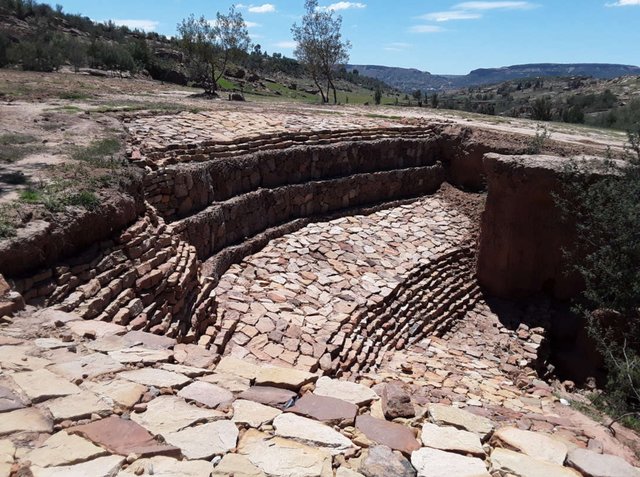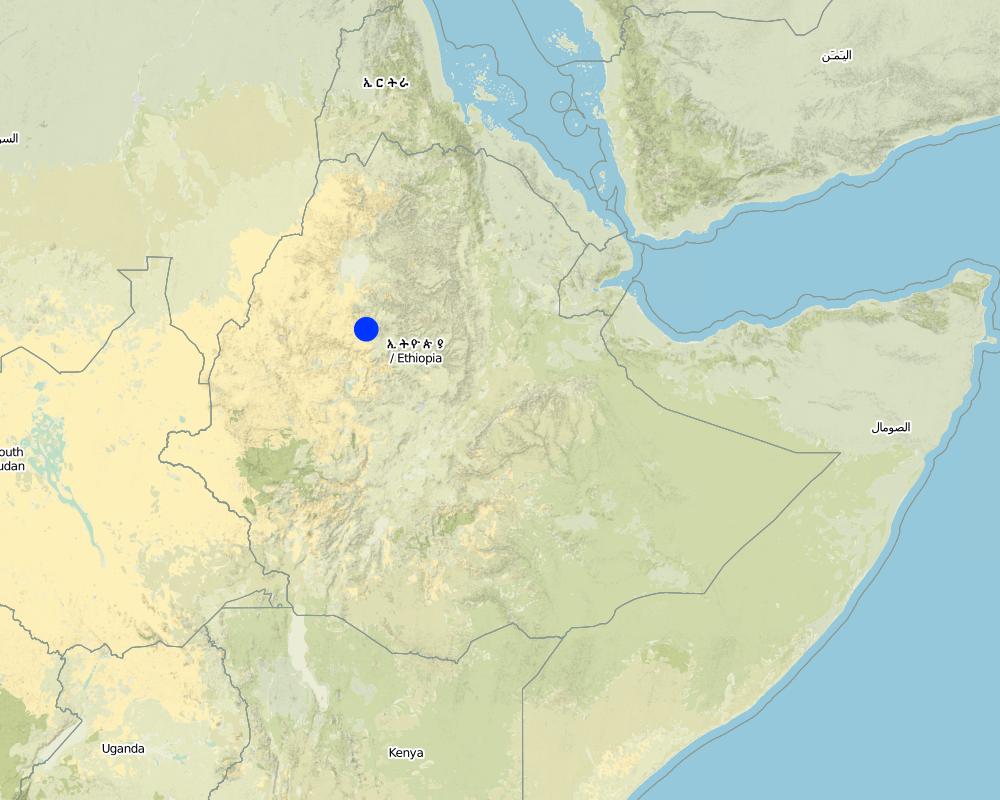Social Infrastructure for Soil Conservation [เอธิโอเปีย]
- ผู้สร้างสรรค์:
- การอัพเดท:
- ผู้รวบรวม: Hans Hurni
- ผู้เรียบเรียง: –
- ผู้ตรวจสอบ: Fabian Ottiger
approaches_2390 - เอธิโอเปีย
ดูส่วนย่อย
ขยายทั้งหมด ย่อทั้งหมด1. ข้อมูลทั่วไป
1.2 รายละเอียดที่ติดต่อได้ของผู้รวบรวมและองค์กรที่เกี่ยวข้องในการประเมินและการจัดเตรียมทำเอกสารของแนวทาง
ชื่อของโครงการซึ่งอำนวยความสะดวกในการทำเอกสารหรือการประเมินแนวทาง (ถ้าเกี่ยวข้อง)
CDE Centre for Development and Environment (CDE Centre for Development and Environment) - สวิตเซอร์แลนด์1.3 เงื่อนไขที่เกี่ยวข้องกับการใช้ข้อมูลที่ได้บันทึกไว้ผ่านทาง WOCAT
ผู้รวบรวมและวิทยากรหลักยอมรับเงื่อนไขเกี่ยวกับการใช้ข้อมูลที่ถูกบันทึกผ่านทาง WOCAT:
ใช่
1.4 การอ้างอิงถึงแบบสอบถามเรื่องเทคโนโลยี SLM

Gully head structure [เลโซโท]
The aim of the gully head structure is to help stabilise the gully and prevent/control the gully from expanding further in length due to erosion. In Lesotho, this is constructed using stones.
- ผู้รวบรวม: Matoka Moshoeshoe
2. คำอธิบายของแนวทาง SLM
2.1 การอธิบายแบบสั้น ๆ ของแนวทาง
Negotiation with the stakeholder community of a catchment on social incentives to be offered by external agency in exchange of additional inputs by the communty to be invested into soil and water conservation measures.
2.2 การอธิบายอย่างละเอียดของแนวทาง
การอธิบายอย่างละเอียดของแนวทาง:
Aims / objectives: The overall purposeof the approach is to achieve sustainable land management without direct incentives such as food-for-work, cash payment, etc. Instead, the community is contracted through a negotiation process to invest into conservation without any direct incentives. Instead, the community will be entitled to select a social investment in their territory which conforms to its most pressing needs, e.g. a clinic, a school, a road, etc. Specific objective is to persuade farmers of the virtue of sustainable land management without direct pay, and to show that outside help is tied to this long-term community commitment when investing into social infrastrcuture. In the end, this is a win-win situation because two goals are achieved with a much greater investment and commitment from the farmer side, while sustainable land management and social development are furthered.
2.5 ประเทศ ภูมิภาค หรือสถานที่ตั้งที่ได้นำแนวทางไปใช้
ประเทศ:
เอธิโอเปีย
ภูมิภาค/รัฐ/จังหวัด: :
Gojam
Map
×2.6 วันที่เริ่มต้นและสิ้นสุดของแนวทาง
ระบุปีที่เริ่ม:
1985
การสิ้นสุดลง (ถ้าแนวทางไม่ได้ใช้อีกต่อไป):
1988
2.7 ประเภทของแนวทาง
- ใช้โครงงานหรือแผนงานเป็นฐาน
2.8 เป้าหมายหรือวัตถุประสงค์หลักของแนวทาง
The Approach focused mainly on SLM with other activities (Area closure / cut & carry of grass. Clinic construction & facilitation.)
There is no document, but the SCRP goal is to support sustainable use of natural resources. In Anjeni this should be achieved through a specific incentive at social level.
The SLM Approach addressed the following problems: Accelerating soil erosion. Declining production of crops. Overland runoff destroying crops and producing gullies. Poor social infrastructure in community.
2.9 เงื่อนไขที่เอื้ออำนวยหรือเป็นอุปสรรคต่อการนำเทคโนโลยีภายใต้แนวทางนี้ไปปฏิบัติใช้
บรรทัดฐานและค่านิยมทางสังคม วัฒนธรรม ศาสนา
- เป็นอุปสรรค
lack of community collaboration
Treatment through the SLM Approach: further processes of community development
การจัดตั้งระดับองค์กร
- เป็นอุปสรรค
lack of trained extensionists
Treatment through the SLM Approach: training supprt
กรอบแนวทางในการดำเนินการด้านกฎหมาย (การถือครองที่ดิน สิทธิในการใช้ที่ดินและน้ำ)
- เป็นอุปสรรค
lack of land ownership
Treatment through the SLM Approach: clarify ownership and user rights
The existing land ownership, land use rights / water rights hindered a little the approach implementation But not much. Attitudes of farmers towards investments into their land remain negative.
3. การมีส่วนร่วมและบทบาทของผู้มีส่วนได้ส่วนเสียที่เกี่ยวข้อง
3.1 ผู้มีส่วนได้ส่วนเสียที่เกี่ยวข้องในแนวทางนี้และบทบาท
- ผู้ใช้ที่ดินระดับท้องถิ่นหรือชุมชนระดับท้องถิ่น
Groups of users organised through the project; Working land users were mainly men (Some women and children also participated.)
Women were less involved in planning and implementation of SWC, but more with social infrastructure. In Ethiopia, men traditionally do soil labour in field. The approach included all communities including all households.
- รัฐบาลแห่งชาติ (ผู้วางแผน ผู้ทำการตัดสินใจ)
Ministry of Agriculture
Ministry of Health
- องค์การระหว่างประเทศ
ถ้ามีผู้มีส่วนได้ส่วนเสียหลายคนที่เกี่ยวข้องให้ระบุหน่วยงานตัวแทน:
Expat: Overall principle of conservation for infrastructure approach. Nationals: Design of objectives, activities. Land users: Agreement on approach and specific designs of technology & maintenance.
3.2 การเกี่ยวข้องของผู้ใช้ที่ดินระดับท้องถิ่นหรือชุมชนระดับท้องถิ่นในช่วงต่างๆของแนวทาง
| ความเกี่ยวข้องของผู้ใช้ที่ดินระดับท้องถิ่นหรือชุมชนระดับท้องถิ่น | ระบุผู้ที่มีส่วนเกี่ยวข้องและอธิบายกิจกรรม | |
|---|---|---|
| การริเริ่มหรือการจูงใจ | ไม่มี | |
| การวางแผน | ไม่ลงมือ | interviews/questionnaires |
| การดำเนินการ | ไม่ลงมือ | responsibility for major steps |
| การติดตามตรวจสอบหรือการประเมินผล | ไม่ลงมือ | public meetings; |
| Research | ไม่มี |
3.4 การตัดสินใจเลือกใช้เทคโนโลยี SLM
ระบุผู้ที่ทำการตัดสินใจเลือกเทคโนโลยีมากกว่าหนึ่งวิธีไปปฏิบัติใช้:
- ผู้เชี่ยวชาญ SLM เป็นผู้ตัดสินใจหลัก ที่ติดตามให้คำปรึกษากับผู้ใช้ที่ดิน
การอธิบาย:
consultative. Development of technology was based on existing indigenous technologies which were complemented and perennized. The approach was explained to the farmers, a 10ha demonstration area was established for one year, and the agreement was reached after that time to do it on 100 ha, if social infrastructure support was given.
Decisions on the method of implementing the SLM Technology were made by by SLM specialists alone (top-down). directive (top-down). Proposal by Development Agents was explained to farmers, and their consent used to organize the mass implementation campaign in 1987.
4. การสนับสนุนด้านเทคนิค การสร้างขีดความสามารถ และการจัดการด้านความรู้
4.1 การสร้างขีดความสามารถ / การอบรม
ได้มีการจัดอบรมให้แก่ผู้ใช้ที่ดินหรือผู้มีส่วนได้ส่วนเสียคนอื่น ๆ หรือไม่:
ใช่
ให้ระบุว่าใครเป็นผู้ได้รับการอบรม:
- ผู้ใช้ที่ดิน
- SWC specialists (2), extensionists/trainers (1), politicians/decision makers (1)
รูปแบบการอบรม:
- กำลังดำเนินการ
- ใช้พื้นที่ทำการสาธิต
- จัดการประชุมสู่สาธารณชน
หัวข้อที่พูด:
Technical design of SWC techniques. Institutions on maintenance & modifications.
4.2 การบริการให้คำแนะนำ
ผู้ใช้ที่ดินมีการเข้าถึงการรับบริการให้คำปรึกษาหรือไม่:
ใช่
ระบุว่ามีบริการให้คำปรึกษาหรือไม่:
- ไปเยี่ยมชมสถานที่
การอธิบาย/แสดงความคิดเห็น:
Name of method used for advisory service: Government Extension System.; Key elements: Holding of meetings., Technical layout of SWC techniques., Support in negotiations & follow-up.; 1) Mainly: government's existing extension system, Partly: projects own extension structure and agent; Extension staff: Mainly government employees 2) Target groups for extension: School children/students, Teachers; Activities: Demonstration visits to nearby catchment and preparation of a school b
Advisory service is inadequate to ensure the continuation of land conservation activities; Farmer to extensionist ratio is 1000:1 or worse. Educational status of all is low. Approach of extension still needs improvement.
4.3 การเสริมความแข็งแกร่งให้กับสถาบัน (การพัฒนาองค์กร)
สถาบันได้รับการจัดตั้งขึ้นมาหรือเสริมความแข็งแกร่งโดยแนวทางนี้หรือไม่:
- ใช่ ปานกลาง
ระบุระดับของสถาบันที่ได้รับการเสริมความแข็งแกร่งหรือจัดตั้งขึ้นมา:
- ท้องถิ่น
ระบุประเภทของการให้ความช่วยเหลือสนับสนุน:
- อุปกรณ์
4.4 การติดตามตรวจสอบและประเมินผล
การติดตามตรวจสอบและประเมินผลเป็นส่วนหนึ่งของแนวทางหรือไม่:
ใช่
ความคิดเห็น:
bio-physical aspects were regular monitored through observations
technical aspects were regular monitored through observations
socio-cultural aspects were regular monitored through observations
economic / production aspects were regular monitored through measurements
There were several changes in the Approach as a result of monitoring and evaluation: Technology was adapted according to farmers wishes, namely adjustments of narrow terraces by removing some, overlay of drainage system over terraces and not along them.
Monitoring & extension in still ongoing through SCRP, and since 1984 in Anjeni.
4.5 การวิจัย
การวิจัยเป็นส่วนหนึ่งของแนวทางหรือไม่:
ใช่
ระบุหัวข้อเรื่อง:
- สังคมวิทยา
- เศรษฐศาสตร์หรือการตลาด
- นิเวศวิทยา
- เทคโนโลยี
- Land use dynamics, farming system.
ให้ข้อมูลเพิ่มเติมและให้ระบุผู้ทำการวิจัย:
The treated catchment of Anjeni is part of a research set-up where continuous monitoring and evaluation is being carried out since 1984.
Research was carried out on-farm
5. การสนับสนุนด้านการเงินและวัสดุอุปกรณ์
5.1 ระบุงบประมาณประจำปีสำหรับแนวทาง SLM นี้
ถ้าหากว่างบประมาณประจำปีไม่เป็นที่ทราบแน่นอน ให้ระบุช่วงลงไป:
- 10,000-100,000
แสดงความคิดเห็น (แหล่งของการระดมทุน ผู้บริจาคคนสำคัญ):
Approach costs were met by the following donors: international (GDE/SCRP): 25.0%; government (national - Min. of Agriculture): 5.0%; local community / land user(s) (-): 70.0%
5.2 การสนับสนุนด้านการเงิน / วัสดุอุปกรณ์ให้แก่ผู้ใช้ที่ดิน
ผู้ใช้ที่ดินได้รับการสนับสนุนด้านการเงิน / วัสดุอุปกรณ์ไปปฏิบัติใช้เทคโนโลยีหรือไม่:
ใช่
5.3 เงินสนับสนุนสำหรับปัจจัยนำเข้า (รวมถึงแรงงาน)
- อุปกรณ์
| ระบุปัจจัยนำเข้าที่ได้รับการสนับสนุน | เห็นด้วยระดับไหน | ระบุเงินสนับสนุน |
|---|---|---|
| เครื่องมือ | ได้รับการช่วยเหลือทางการเงินแบบเต็ม | Hand tools |
- โครงสร้างพื้นฐาน
| ระบุปัจจัยนำเข้าที่ได้รับการสนับสนุน | เห็นด้วยระดับไหน | ระบุเงินสนับสนุน |
|---|---|---|
| Community infrastructure | ได้รับการช่วยเหลือทางการเงินบางส่วน | Support to clinic was 50% of cost of clinic only. |
ถ้าแรงงานโดยผู้ใช้ที่ดินเป็นปัจจัยนำเข้าที่มีอยู่มากมาย ระบุด้วยว่าเนื่องจาก:
- สมัครใจ
ความคิดเห็น:
In exchange of SWC works support to clinic was given as an overall incentive.
5.4 เครดิต
มีการจัดหาเครดิตมาให้ภายใต้แนวทาง SLM หรือไม่:
ไม่ใช่
6. การวิเคราะห์ผลกระทบและการสรุป
6.1 ผลกระทบของแนวทาง
ช่วยให้ผู้ใช้ที่ดินนำเอาเทคโนโลยี SLMไปใช้และบำรุงรักษาสภาพไว้ได้หรือไม่:
- ไม่ใช่
- ใช่ เล็กน้อย
- ใช่ ปานกลาง
- ใช่ อย่างมาก
Traditional soil fertility management was already exhaustively used under the given farming system.
ปรับปรุงประเด็นของการถือครองที่ดินหรือสิทธิในการใช้ ซึ่งขัดขวางการนำเทคโนโลยีไปใช้ให้ดีขึ้น:
- ไม่ใช่
- ใช่ เล็กน้อย
- ใช่ ปานกลาง
- ใช่ อย่างมาก
The problem is unlikely to be overcome in the near future. Present government insists on state ownership of land.
Did other land users / projects adopt the Approach?
- ไม่ใช่
- ใช่ เล็กน้อย
- ใช่ ปานกลาง
- ใช่ อย่างมาก
A large programme in Merhabete involving 2,000 ha and about 10,000 people adopted a similar system, however with a technology that was suitable to their area (level bunds).
6.3 ความยั่งยืนของกิจกรรมของแนวทาง
ผู้ใช้ที่ดินสามารถทำให้สิ่งต่างๆ ที่ได้ปฏิบัติใช้โดยแนวทางนี้ยั่งยืนได้หรือไม่ (โดยไม่มีการสนับสนุนจากภายนอก):
- ไม่
ถ้าตอบว่าไม่หรือไม่แน่ใจ ให้ระบุและแสดงความคิดเห็น :
Social incentives will have to come from outside (government or NGO)
6.4 จุดแข็งและข้อได้เปรียบของแนวทาง
| จุดแข็ง / ข้อได้เปรียบของแนวทางในทัศนคติของผู้ใช้ที่ดิน |
|---|
| Fulfillment of community needs (How to sustain/ enhance this strength: Co-ordination and participatory approach) |
| All catchment land users do conservation jointly together (How to sustain/ enhance this strength: Community versus individual approach) |
| จุดแข็ง / ข้อได้เปรียบของแนวทางในทัศนคติของผู้รวบรวมหรือวิทยากรหลัก |
|---|
| Negotiation processes (How to sustain/ enhance this strength: Train extensionists) |
| Social incentives (How to sustain/ enhance this strength: Better cooperation between different ministries on their activities as a package) |
6.5 จุดอ่อน / ข้อเสียเปรียบของแนวทางและวิธีในการแก้ไข
| จุดอ่อน / ข้อเสียเปรียบในทัศนคติของผู้ใช้ที่ดิน | สามารถแก้ไขปัญหาได้อย่างไร |
|---|---|
| Combining two goals necessitates more labour inputs | No solution |
| จุดอ่อน / ข้อเสียเปรียบในทัศนคติของผู้รวบรวมหรือวิทยากรหลัก | สามารถแก้ไขปัญหาได้อย่างไร |
|---|---|
| Tieing social investments with soil conservation is politically difficult because two goals are pursued with one instrument | No option but continue |
| Interest may still be initiated basically from need and less from degradation | Awareness needs to be furthered still |
7. การอ้างอิงและการเชื่อมต่อ
7.1 วิธีการหรือแหล่งข้อมูล
- ไปเยี่ยมชมภาคสนาม การสำรวจพื้นที่ภาคสนาม
- การสัมภาษณ์กับผู้ใช้ที่ดิน
7.2 การอ้างอิงถึงสิ่งตีพิมพ์
ชื่อเรื่อง ผู้เขียน ปี ISBN:
SCRP Progress Reports
ช่องทางในการสืบค้น และราคา:
SCRP, Addis Abeba
ชื่อเรื่อง ผู้เขียน ปี ISBN:
Book Learning from Anjeni' (Amharic)'
ช่องทางในการสืบค้น และราคา:
Min. of Education, Bahr Dar
ชื่อเรื่อง ผู้เขียน ปี ISBN:
SCRP Research Reports
ช่องทางในการสืบค้น และราคา:
SCRP, Addis Abeba
ลิงก์และโมดูล
ขยายทั้งหมด ย่อทั้งหมดลิงก์

Gully head structure [เลโซโท]
The aim of the gully head structure is to help stabilise the gully and prevent/control the gully from expanding further in length due to erosion. In Lesotho, this is constructed using stones.
- ผู้รวบรวม: Matoka Moshoeshoe
โมดูล
ไม่มีโมดูล


